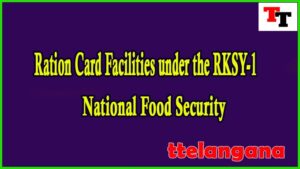Ration Card Facilities under the RKSY-1 Scheme Enhancing Food Security and Welfare
The right to food is a fundamental human right which ensures that all individuals have access to adequate and nutritious food. Recognizing the importance of food security, governments around the world have implemented various schemes and policies. In India, the National Food Security Act (NFSA) of 2013 plays a vital role in providing food security to millions of citizens. Under this Act, the RKSY-1 (Rajiv Gandhi Kisan Swayam Sahayatha Yojana) scheme was introduced, which focused on increasing the reach and effectiveness of ration card facilities. The various benefits of the RKSY-1 scheme are aimed at promoting food security and welfare among the Indian population.
-
Overview of the RKSY-1 Scheme:
The RKSY-1 scheme, introduced under the NFSA, aims to expand the coverage of ration cards to ensure that no eligible person is left out from receiving subsidized food grains. The scheme takes its name from former Prime Minister Rajiv Gandhi and aims to provide assistance to farmers, agricultural workers, and other vulnerable groups. It primarily focuses on targeting individuals in rural areas and aims to address the issues of food insecurity and poverty.
-
Key Features and Provisions:
a. Ration Card Types: The RKSY-1 scheme introduces three types of ration cards – Antyodaya Anna Yojana (AAY) cards, Priority Households (PHH) cards, and General Household (GH) cards. These categories ensure that different sections of society receive the appropriate level of assistance based on their needs.
b. Subsidized Food Grains: The scheme provides subsidized food grains to eligible beneficiaries through the Public Distribution System (PDS). Rice, wheat, and coarse grains are distributed at affordable prices, ensuring access to essential nutritional resources.
c. Aadhaar Integration: The RKSY-1 scheme integrates the Aadhaar system, which helps in eliminating duplicate and fake ration cards, thus ensuring targeted delivery of benefits to the rightful beneficiaries.
d. Cash Transfers: The scheme also includes direct cash transfers to eligible households, providing them with flexibility in purchasing food items of their choice. This provision empowers beneficiaries to make decisions based on their preferences and dietary requirements.

-
Target Beneficiaries:
a. Farmers and Agricultural Laborers: The RKSY-1 scheme recognizes the pivotal role played by farmers and agricultural laborers in ensuring food security. By providing them with subsidized food grains and cash transfers, the scheme supports their well-being and livelihoods.
b. BPL Families: The Below Poverty Line (BPL) families constitute a significant section of the population facing economic hardships. The scheme aims to alleviate their burden by ensuring food security and offering assistance through various provisions.
c. Vulnerable Groups: The RKSY-1 scheme also extends its benefits to vulnerable groups such as widows, elderly individuals, persons with disabilities, and single women. By including these marginalized sections, the scheme strives to create an inclusive and equitable food distribution system.
-
Impact on Food Security and Welfare:
a. Enhanced Access to Nutritious Food: The RKSY-1 scheme plays a crucial role in improving access to nutritious food for millions of households across the country. By providing subsidized food grains and cash transfers, the scheme ensures that individuals can afford a balanced diet, contributing to improved health outcomes.
b. Poverty Alleviation: The scheme’s provisions help reduce the economic burden on marginalized families by providing subsidized food grains and cash transfers. This, in turn, helps alleviate poverty and improves the overall living conditions of beneficiaries.
c. Empowerment and Social Inclusion: The RKSY-1 scheme empowers beneficiaries by giving them the freedom to choose the food items they require, thus promoting their dignity and autonomy. Additionally, the scheme’s focus on including vulnerable groups helps foster social inclusion and address inequalities in access to food resources.
-
Implementation Challenges and the Way Forward:
While the RKSY-1 scheme holds immense potential in promoting food security and welfare, certain challenges need to be addressed for its effective implementation. These challenges include ensuring accurate identification of beneficiaries, efficient supply chain management, and overcoming infrastructural limitations. Additionally, periodic monitoring and evaluation of the scheme’s progress are crucial to identifying areas for improvement and addressing gaps in service delivery.
Conclusion:
The RKSY-1 scheme, introduced under the National Food Security Act, stands as a significant step towards ensuring food security and welfare for the Indian population. Through its provisions of subsidized food grains, cash transfers, and targeted assistance to vulnerable groups, the scheme plays a crucial role in uplifting the living standards of marginalized communities. By addressing the challenges and continuously refining the implementation process, the RKSY-1 scheme has the potential to make a lasting impact on food security and contribute to the overall well-being of the nation.